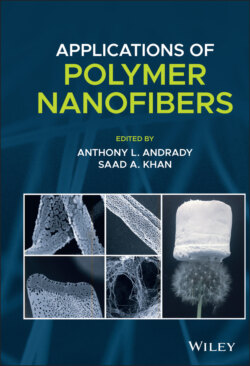Читать книгу Applications of Polymer Nanofibers - Группа авторов - Страница 27
1.6.3.2 Emulsion Electrospinning
ОглавлениеCoelectrospinning multiple fluids from a single spinneret to achieve core–shell fibers via phase separation is an alternative to coaxial electrospinning (Crespy et al. 2012; Yarin 2011). For example, when a polymer solution is emulsified with an immiscible solution (stabilized by surfactants) is electrospun, coaxial fibers can be achieved (Bannwarth et al. 2015; Bazilevsky et al. 2007; Xiaoqiang et al. 2017; Xu et al. 2006; Yang et al. 2008; Cai et al. 2016; Camerlo et al. 2013; Hu et al. 2014; Hu and Huang 2007; Jagur‐Grodzinski 2006; Li et al. 2010; Maretschek et al. 2008; Qi et al. 2006). The continuous phase of the emulsion is an electrospinnable polymer solution. During electrospinning, the dispersed droplets are stretched and elongated. Since the solvent evaporates from the outer shell solution faster than the core solution, the viscosity of the shell increases relative to the core. The viscosity gradient from the outer to inner layer forces the stretched droplets inward so that the dispersed phase is encapsulated within the fiber (Xu et al. 2006). Partial de‐emulsification, i.e. merging of the droplets during fiber formation is thought to result in a continuous core of dispersed phase (Hu et al. 2014). Mathematic modeling of the two‐phase flow indicates that annular flow, i.e. a continuous core, is expected when the Weber number is less than 0.5 and greater than 26 (Hu and Huang 2007). Note the Weber number is
(1.11)
where ρ is the density of the core solution, v is the velocity of the core solution at the exit of the nozzle, douter is the diameter of the outer needle, and σ is the surface tension coefficient (Hu and Huang 2007).
Oil‐in‐water (O/W) emulsions in which a hydrophobic component is encapsulated within a hydrophilic polymer (Xu et al. 2006; Maretschek et al. 2008; Qi et al. 2006) as well as water‐in‐oil (W/O) in which hydrophilic components are encapsulated within a water insoluble polymer (Bannwarth et al. 2015; Camerlo et al. 2013) have been reported. For O/W emulsions, typical core loadings are ~20% or less (weight ratio of core material to shell polymer) (Choi et al. 2011). The loading of dispersed phase in the nanofiber is typically 5% or less (mass of core:mass of shell polymer) for W/O systems (Yang et al. 2008). Thus, using emulsions, the loading of core materials is typically less than can be achieved with coaxial electrospinning. Surfactants are generally used to stabilize the emulsion. Surfactants with low HLB (hydrophile–lipophile balance) have been used to stabilize oil‐in‐water emulsions for electrospinning (e.g. sorbitan monooleate) (Cai et al. 2016). Surfactants with high HLB, e.g. sodium dodecyl sulfate, have been used to stabilize both oil‐in‐water and water‐in‐oil emulsions for electrospinning (Bannwarth et al. 2015; Xu et al. 2006; Yang et al. 2008). The emulsion is usually electrospun immediately after preparation to prevent premature phase separation (Cai et al. 2016; Camerlo et al. 2013; Garcia‐Moreno et al. 2016). Stabilizing the emulsion is a critical practical consideration.
